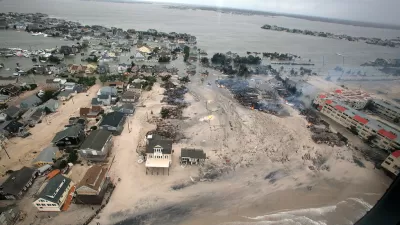In the aftermath of Hurricane Sandy, the news media were fixated on the plight of middle-class homeowners in places like the Rockaways in Queens. But two new reports show that low-income renters were the more prevalent victims of the storm.
Matt Chaban discusses the findings of two new studies released this week - one by the Furman Center for Real Estate and Urban Policy at NYU [PDF], the other by affordable housing developers Enterprise Community Partners [PDF] - that show "Sandy is more likely to have struck a low-income family that rents an apartment than a more well-off one that owns a home."
According to Chaban, the studies "found that of the 150,000 families who have applied for FEMA housing aid, 56% were renters, rather than homeowners. What's more it found that 61% of applicants make less than $60,000 a year, with half that group making less than $15,000 a year."
"'With almost 50% of households making $30,000 a year or less, this is a big deal,' said Shola Olatoye, vice president and New York market leader at Enterprise. 'These are low-income families already in need, and Sandy has made things so much worse.'"
"The authors of the studies hope that their data will help drive the policy debates to come," adds Chaban. "With tens of billions of dollars in federal aid at stake, they believe the money must be spent carefully, and may not even be enough to cover the recovery costs. After all, renters are not typically the ones with the insurance policies, so it can be hard to force a landlord to make repairs."
FULL STORY: Sandy hit the poor hardest in New York

Trump Administration Could Effectively End Housing Voucher Program
Federal officials are eyeing major cuts to the Section 8 program that helps millions of low-income households pay rent.

Planetizen Federal Action Tracker
A weekly monitor of how Trump’s orders and actions are impacting planners and planning in America.

Ken Jennings Launches Transit Web Series
The Jeopardy champ wants you to ride public transit.

California Invests Additional $5M in Electric School Buses
The state wants to electrify all of its school bus fleets by 2035.

Austin Launches $2M Homelessness Prevention Fund
A new grant program from the city’s Homeless Strategy Office will fund rental assistance and supportive services.

Alabama School Forestry Initiative Brings Trees to Schoolyards
Trees can improve physical and mental health for students and commnity members.
Urban Design for Planners 1: Software Tools
This six-course series explores essential urban design concepts using open source software and equips planners with the tools they need to participate fully in the urban design process.
Planning for Universal Design
Learn the tools for implementing Universal Design in planning regulations.
Ada County Highway District
Clanton & Associates, Inc.
Jessamine County Fiscal Court
Institute for Housing and Urban Development Studies (IHS)
City of Grandview
Harvard GSD Executive Education
Toledo-Lucas County Plan Commissions
Salt Lake City
NYU Wagner Graduate School of Public Service



























